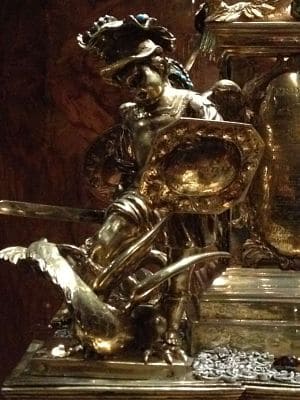Non pro te lex — the law is not for you — I read on a shield held by a sturdy harnessed putto at the foot of a pillar devoted to the Virgin Mary in the centre of Vienna — and I am immediately intrigued: what was that supposed to tell the seventeenth-century Viennese? As a historian looking at exception-making and rule-breaking in the early modern period, I am always ready to be surprised by the ambiguities, contradictions and daring of people in that period – but this blast from the past hits me with special force, perhaps also because of the glare and stifling heat of that summer afternoon.
The learned guide taking us around some of the Latin inscriptions in Vienna that hot afternoon explains that it is a statement about the Immaculate Conception of the Virgin, that is to say: the God-given “law” of the original sin does not apply to her. I am not entirely satisfied with this explanation, sensing that the statement must also have something to do with manmade law. Also because I smell a great cover image for my book about rule-breaking, I decide to research this thoroughly.

As nephew and brother in law of the Elector of Bavaria, the Austrian emperor visited Munich in 1641, and after his own city also escaped the Swedish threat after an appeal to Mary’s intercession he seems to have wanted to give the same shape to his gratitude as his double relative. The pillar erected in stone Am Hof in Vienna was very similar to the one in Munich, and replaced by a copy in bronze two decades later. Somewhere in the process two more biblical references were added to the shields of the bronze putti. Beside the parts of the verse from psalm 90 still on two of the shields, we read on the other two: non pro te lex – which we are trying to find out more about, and ipsa conteret – she herself will crush. The latter fragment from the book of Genesis in the Old Testament has long been interpreted by Catholic theologians as a reference to Mary crushing the snake representing sin.
But now back to non pro te lex. Google finds for us that the words are taken from a verse in the story of Esther in the Vulgate Bible, or more precisely one of the verses that Jerome considered to be additions to the book of Esther when he compiled the Vulgate. The full verse reads: Non morieris: non enim pro te, sed pro omnibus haec lex constituta est – You will not die: for this law has not been instituted for you, but for the public. And this quote transports us to the glittering court of Xerxes the Great, who, according to the Bible took the beautiful, and closeted Jewish, Esther as his queen. And there she is in this passage ready to die in order to redeem her people with rosy cheeks and bright eyes. Looking radiant externally, she is ready to faint inside. But Xerxes extends his sceptre to her and with that gesture lifts the law setting the death penalty upon uncalled for appearances in his presence – this manmade law is not for her — and she delivers the Jews of the Persian Empire from extermination, while they are given permission to exterminate their enemies within the empire instead.
This Old Testament text about Esther was, however, at the time of the creation of our bronze putto understood as presaging the birth of Mary. Google summons an Italian sermon of the era about the Virgin Mary which makes precisely this analogy: just as Esther saved her people from death before the king, so Mary intercedes on behalf of the whole of humanity – and only she can do this for she is the only one excepted from the general law of the original sin – esente dalla legge comune del peccato. Through her exceptional, immaculate, birth Mary becomes the deliverer. And what the seventeenth-century Viennese wanted was to be delivered from pestilence, evil and hell – they wanted to be that exception.
Yet the doctrine of the Immaculate Conception was contested by Luther and the context of the pillar in the centre of Vienna was also the recatholisation of the city which had had a Protestant, mostly Lutheran, majority less than a century before. The bronze putto with non pro te lex on his shield is precisely the one killing the basilisk, the animal representing schism, signalling that the Lutheran schismatics were vanquished in the sign of the doctrine they belied. From the start, the pillar was intended as an important node in the renewed Catholic spiritual life of the city. Not only did the emperor call a meeting of the estates of Austria and the magistrate of Vienna to dedicate Austria (the core of the empire) to the Virgin on the occasion of the inauguration of the pillar, a few years later it also became compulsory for the professors and dissertators at the university of Vienna to vow on the doctrine of the Immaculate Conception and to renew that vow annually with a procession to the pillar (Tipton, pp. 380-3). The pillar thus defined the boundaries of academic expression in Vienna until the annual procession was abolished in 1782.
Yet amid all this authoritative discourse, or discourse from authority, one thing stands out: the word lex, or law, is given a negative valuation in the context of the putto killing the basilisk at the foot of the pillar on which Mary stands on a dying dragon. There is the burdensome law for omnibus — all, or the public, and there is the exception for the good Mary, who stands far above us all. Yet this negative valuation was not as exceptional at the time as it may seem. On the other side of the divided church, Luther had elevated the Grace that was embodied by the New Testament over the Law that was the Old Testament. Grace was the way for him, not the nitty-gritty of the Law. Seen in this light the non pro te lex does not exactly represent a call to anarchy, but it does represent a measure of reflection on the application of law, a moment in which exceptions for those with a redeeming role were valorised.
Reference: Susan Tipton, “Super aspidem et basiliscum ambulabis.” Zur Entstehung der Mariensäulen im 17. Jahrhundert. In Dieter Breuer ed., Religion und Religiosität im Zeitalter des Barok, vol. 1: 375-98. Wiesbaden, 1995. Unfortunately Tipton’s well-founded interpretation of the four animals has been disregarded in subsequent writings on the topic, for which reason the view that they were meant to represent the four scourges of hunger, war, pestilence and unbelief is still current in the literature and on the web.
Image credits: Photograph 2013 by Jonathan Hinkle of the basilisk-slaying putto erected in 1667 Am Hof as redesigned bronze by Lodovico Ottavio Burnacini after the earlier stone version of Johann Jacob Pock. Photograph 2013 by Ariane Kruijtzer of a miniature version of the same basilisk-slaying putto created in silver gilded iron by the Augsburger artist Philipp Küsel c. 1675-8, and kept in the imperial treasury museum in Vienna.
With thanks to Friedrich Polleross for pointing out the right literature and Peter Roland for that memorable tour of Vienna’s Latin inscriptions.









